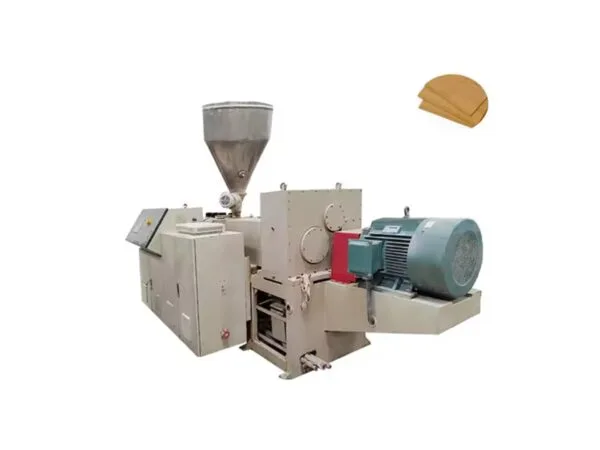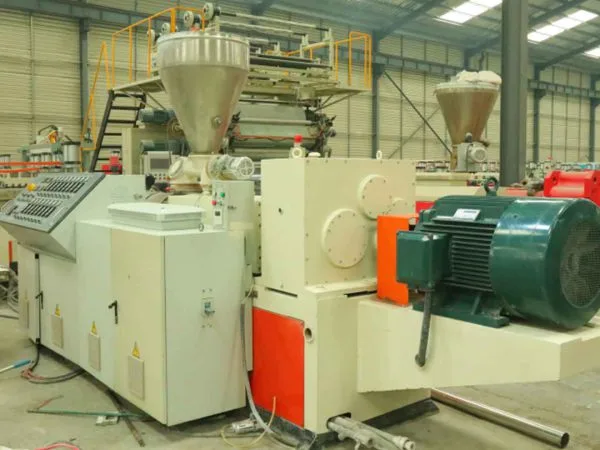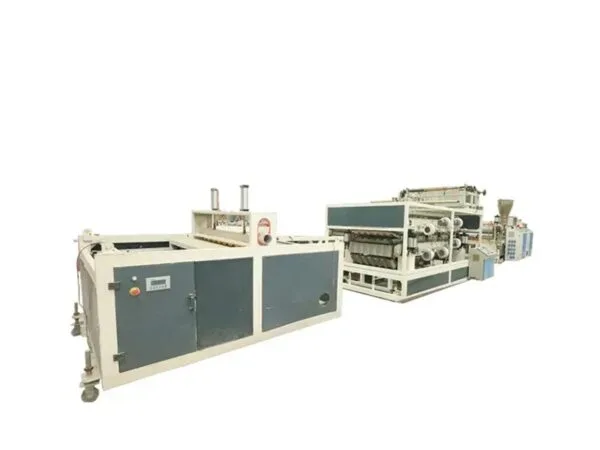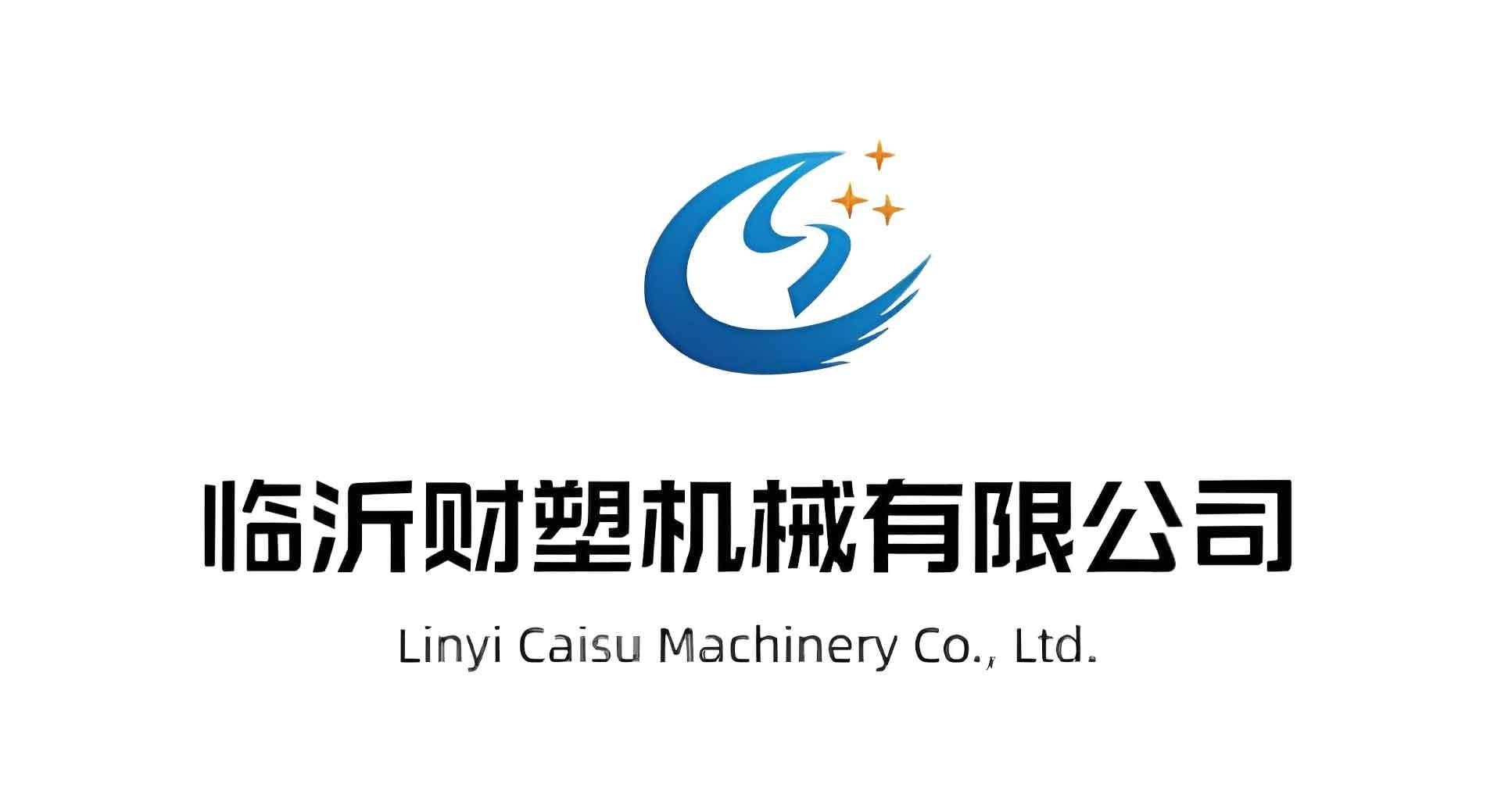Welcome to My Blog!
Before we dive into the content, I’d love for you to join me on my social media platforms where I share more insights, engage with the community, and post updates. Here’s how you can connect with me:
Facebook:https://www.facebook.com/profile.php?id=61567891941530
Now, let’s get started on our journey together. I hope you find the content here insightful, engaging, and valuable.
Caisu Machinery sells a variety of used plastic pipe production equipment. The products are of high quality and low price. Welcome to contact us for consultation and purchase. We will be happy to serve you.
Table of Contents
Introduction
PVC wood plastic profile equipment is at the forefront of modern manufacturing, producing wood plastic composites (WPCs) that blend the aesthetics of wood with the durability of PVC. This specialized machinery, primarily extrusion lines, creates profiles for applications like decking, fencing, and siding, offering sustainable alternatives to traditional materials.
By combining wood fiber with PVC, PVC wood plastic profile equipment delivers products that resist moisture, rot, and UV damage, making them ideal for construction and outdoor use.
Understanding PVC Wood Plastic Profile Equipment

PVC wood plastic profile equipment refers to machinery, primarily extruders, designed to produce WPC profiles by blending wood flour or fiber with polyvinyl chloride (PVC) and additives. These machines melt, mix, and shape the composite into profiles like boards, trims, or railings, used in construction, furniture, and automotive industries. The equipment’s ability to produce durable, lightweight, and customizable profiles has made it a cornerstone of sustainable manufacturing. This section delves into the equipment’s components, processes, and technological advancements, providing a foundation for understanding its applications and benefits.
Components of PVC Wood Plastic Profile Equipment
PVC wood plastic profile equipment typically includes a hopper for raw material input, a twin-screw extruder for melting and mixing, a die for shaping profiles, a cooling bath for solidification, and a cutting unit for precise lengths. Auxiliary systems, like vacuum calibrators and haul-off units, ensure dimensional accuracy and surface quality. Additives such as stabilizers, lubricants, and UV inhibitors are incorporated to enhance WPC properties, as noted in industry sources. These components work in tandem to produce consistent, high-quality profiles tailored to specific applications.
The Extrusion Process in PVC Wood Plastic Profile Equipment
The extrusion process in PVC wood plastic profile equipment begins with feeding wood flour (30–60% by weight) and PVC resin into the hopper, along with additives like coupling agents and colorants. The twin-screw extruder heats and mixes the materials at 150–200°C, preventing wood degradation, as highlighted by Bausano. The molten composite is forced through a die to form the desired profile shape, then cooled in a water bath and cut to length. This continuous process ensures high output and precision, making it ideal for large-scale production of WPC profiles.
Technological Advancements in PVC Wood Plastic Profile Equipment
Recent advancements in PVC wood plastic profile equipment include energy-efficient extruders, automated control systems, and inline recycling capabilities. Modern machines, like those from General Kinematics, incorporate vibratory systems for precise material handling, reducing waste. Smart sensors monitor temperature and pressure, optimizing output quality, while bio-based PVC formulations enhance sustainability, as per SpecialChem. These innovations improve production efficiency, lower environmental impact, and expand the range of profiles, from decking to automotive trims, produced by PVC wood plastic profile equipment.
Applications of PVC Wood Plastic Profile Equipment

PVC wood plastic profile equipment produces WPC profiles for diverse industries, leveraging the material’s durability, moisture resistance, and aesthetic versatility. From construction to consumer goods, the equipment’s output replaces traditional materials like wood and metal, offering low-maintenance, long-lasting solutions. This section explores key applications, supported by industry insights, to illustrate the equipment’s versatility.
Construction Applications of PVC Wood Plastic Profile Equipment
In construction, PVC wood plastic profile equipment produces profiles for decking, siding, and window frames. WPC decking, resistant to moisture and UV rays, outperforms wood, lasting 15–20 years with minimal maintenance, as noted by Bausano. Siding and cladding profiles, used in residential and commercial buildings, provide insulation and weather resistance, reducing energy costs. Window profiles, made with rigid PVC WPC, offer durability and thermal efficiency, replacing wood and aluminum in modern architecture.
Outdoor Applications of PVC Wood Plastic Profile Equipment
PVC wood plastic profile equipment is widely used for outdoor applications like fencing, railings, and garden structures. WPC fences and railings, produced by extrusion, resist rot, rust, and insect damage, unlike wood or metal, as per Xtruline. Their lightweight nature simplifies installation, while customizable colors and wood-grain finishes enhance aesthetics. These profiles are ideal for parks, residential properties, and coastal areas, where exposure to weather demands robust materials.
Furniture and Interior Design with PVC Wood Plastic Profile Equipment
In furniture and interior design, PVC wood plastic profile equipment creates trims, panels, and decorative moldings. WPC panels mimic wood’s appearance but offer superior moisture resistance, making them suitable for bathroom and kitchen cabinetry. Furniture trims and edge profiles, produced with high precision, enhance durability and reduce maintenance, as noted by Condale Plastics. The equipment’s ability to produce complex shapes supports innovative designs in commercial and residential interiors.
Automotive and Transportation Uses of PVC Wood Plastic Profile Equipment
The automotive and transportation sectors use PVC wood plastic profile equipment to produce interior trims, door seals, and dashboard panels. WPC profiles offer lightweight strength and thermal stability, improving fuel efficiency in vehicles, as per BPF. In caravans and RVs, WPC trims and skirt-rails provide durability and aesthetic consistency, replacing heavier materials. The equipment’s precision ensures profiles meet stringent industry standards for safety and performance.
Specialty Applications of PVC Wood Plastic Profile Equipment
Specialty applications of PVC wood plastic profile equipment include marine structures, agricultural supports, and signage. WPC marine decking withstands saltwater exposure, outperforming wood, as noted by Tangent Materials. Agricultural trellises and greenhouse frames benefit from WPC’s chemical and weather resistance. In advertising, WPC signage panels, produced by extrusion, offer durability and UV stability, ensuring long-lasting outdoor displays.
Comparison Table and Performance Insights for PVC Wood Plastic Profile Equipment
To clarify the applications of PVC wood plastic profile equipment, the following table summarizes key uses, material properties, and benefits, providing a reference for manufacturers and builders.
| Application | Material Properties | Benefits | Industry Examples |
|---|---|---|---|
| Decking | Moisture-resistant, UV-stable | Long lifespan (15–20 years), low maintenance | Residential patios, boardwalks |
| Siding/Cladding | Insulating, weather-resistant | Energy-efficient, durable, aesthetic | Commercial buildings, homes |
| Fencing/Railings | Rot-resistant, lightweight | Easy installation, weatherproof | Parks, coastal properties |
| Window Frames | Rigid, thermally efficient | Durable, energy-saving | Modern architecture, renovations |
| Furniture Trims | Flexible, moisture-resistant | Customizable, low maintenance | Kitchen cabinets, office furniture |
| Automotive Trims | Lightweight, thermally stable | Fuel-efficient, durable | Car interiors, RV trims |
| Marine Structures | Saltwater-resistant, UV-stable | Long-lasting, low maintenance | Docks, piers |
Performance Insights for PVC Wood Plastic Profile Equipment
The table highlights the versatility of PVC wood plastic profile equipment across industries. Decking and siding benefit from WPC’s moisture and UV resistance, reducing replacement costs compared to wood. Fencing and railings leverage lightweight profiles for easy installation, while window frames enhance energy efficiency. Furniture and automotive trims showcase the equipment’s precision in producing complex, durable profiles. Marine applications underscore WPC’s superiority in harsh environments. The equipment’s ability to tailor wood-to-PVC ratios (e.g., 60% wood for strength) optimizes performance, as per Bausano, making it a sustainable choice.
Optimizing Use of PVC Wood Plastic Profile Equipment
To maximize PVC wood plastic profile equipment performance, select extruders with high torque for processing high-wood-content composites. Use additives like UV stabilizers for outdoor profiles, as advised by SpecialChem. Regular maintenance, such as cleaning screws and calibrating dies, ensures consistent output, per General Kinematics. Train operators on temperature control (150–200°C) to prevent wood degradation, and integrate recycling systems to reuse scrap, enhancing sustainability and cost-efficiency.
Practical Considerations for PVC Wood Plastic Profile Equipment

Effective use of PVC wood plastic profile equipment involves strategic selection, operation, and maintenance. This section provides actionable guidance for manufacturers and engineers.
Selecting PVC Wood Plastic Profile Equipment
Choosing PVC wood plastic profile equipment requires assessing production needs, such as output volume and profile complexity. Twin-screw extruders, like those from Bausano, suit high-volume production, while single-screw models are cost-effective for smaller operations. Consider automation features, like PLC controls, for precision, and ensure compatibility with bio-based PVC resins for sustainability, as per SpecialChem. Consult suppliers like Plastic Extrusion Technologies for custom die designs to meet specific profile requirements.
Operating PVC Wood Plastic Profile Equipment
Operating PVC wood plastic profile equipment demands precise control of temperature, screw speed, and material ratios. Maintain extrusion temperatures at 150–200°C to protect wood fibers, as noted by Bausano. Adjust wood content (30–60%) based on application—higher for strength, lower for flexibility. Use inline quality checks, like laser gauges, to ensure dimensional accuracy. Train operators on safety protocols, especially when handling hot dies, to prevent burns and ensure consistent production quality.
Maintenance of PVC Wood Plastic Profile Equipment
Regular maintenance of PVC wood plastic profile equipment extends machine life and ensures quality. Clean extruder screws and barrels weekly to prevent residue buildup, as advised by General Kinematics. Inspect dies for wear and recalibrate cooling baths to maintain profile shape. Lubricate moving parts, like haul-off units, monthly, and update software for automated systems to optimize performance. Schedule annual servicing with manufacturers like Bausano to address wear and improve efficiency.
Environmental Benefits of PVC Wood Plastic Profile Equipment
PVC wood plastic profile equipment supports sustainability by using recycled wood and PVC. WPC profiles, with up to 60% post-industrial wood, reduce deforestation, as per General Kinematics. Recyclable PVC resins, noted by Xtruline, minimize waste, and energy-efficient extruders lower carbon footprints. The equipment’s ability to produce long-lasting profiles (15–100 years) reduces replacement frequency, making it a green alternative to wood and metal in construction and outdoor applications.
Challenges in Using PVC Wood Plastic Profile Equipment
Challenges with PVC wood plastic profile equipment include high initial investment, material sensitivity, and operator training. High-wood-content composites require robust extruders, increasing costs. Wood fibers are prone to thermal degradation above 200°C, requiring precise control, as per SpecialChem. Operators need training to handle complex systems, like automated extruders. Mitigate these by selecting cost-effective models, using smart sensors, and investing in operator certification programs, ensuring efficient and reliable production.
Conclusion
PVC wood plastic profile equipment is a game-changer in manufacturing, producing durable, sustainable WPC profiles for decking, siding, fencing, and more. Its precision, efficiency, and eco-friendly output make it indispensable across industries.
This guide, with its table and FAQ, equips professionals to leverage the equipment’s capabilities, driving innovation in construction and beyond.
FAQ
What is PVC wood plastic profile equipment?
PVC wood plastic profile equipment includes extruders that produce WPC profiles by blending wood flour and PVC for applications like decking and fencing.
What are the main applications of PVC wood plastic profile equipment?
It produces profiles for decking, siding, fencing, window frames, furniture trims, automotive parts, and marine structures, offering durability and aesthetics.
How does PVC wood plastic profile equipment work?
It melts and mixes wood flour, PVC, and additives in a twin-screw extruder, shapes the composite through a die, cools, and cuts it into profiles.
What materials are used in PVC wood plastic profile equipment?
Wood flour (30–60%), PVC resin, and additives like stabilizers, lubricants, and UV inhibitors are used to create durable WPC profiles.
What are the benefits of PVC wood plastic profile equipment?
It produces moisture-resistant, UV-stable, and recyclable profiles, reducing maintenance and environmental impact compared to wood or metal.




